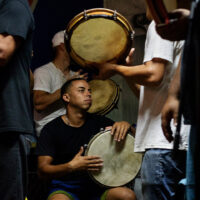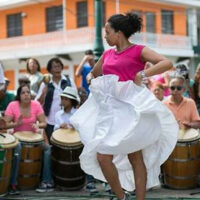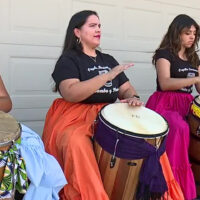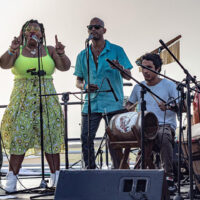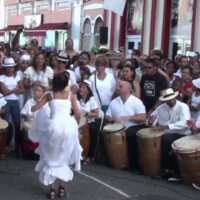
Bomba in Puerto Rico
A Cultural and Musical Explosion

Bomba in Puerto Rico is not just a musical genre; it is a profound expression of Puerto Rican culture—a vibrant and dynamic art form that has transcended generations, survived centuries of oppression, and evolved to inspire new audiences. Rooted in Puerto Rico’s colonial history, Bomba is a unique fusion of African, Taíno, and Spanish influences. Each rhythm, movement, and lyric carries with it stories of the island’s past, its people’s resilience, and their deep connection to identity, community, and celebration. Through music, dance, and lyrics, Bomba continues to serve as both a cultural resistance and a powerful statement of pride.
Emerging during the era of slavery, when enslaved Africans were brought to Puerto Rico, Bomba became a tool for survival—a means of resistance, communication, and cultural preservation.
Over time, Bomba grew to symbolize Puerto Rican unity and identity, transcending its original context to become a central part of cultural festivals, community celebrations, and everyday life. Today, Bomba stands as a testament to the island’s strength and spirit, a symbol of resilience, joy, and cultural pride that resonates far beyond Puerto Rican shores.
The Origins of Bomba
Bomba traces its origins back to the colonial period when African slaves were brought to Puerto Rico. It is believed to be a fusion of African rhythms, indigenous Taíno influences, and Spanish musical elements, forming a genre that reflects the diverse and complex history of the island. The term Bomba likely originates from the word bombear, which means to drum or beat—a reference to the pivotal role of drums in this genre.
In the face of colonial oppression, Bomba became more than just music—it was an act of defiance, a tool of communication, and a way for enslaved Africans to maintain a connection to their homeland and spiritual practices. It served as a powerful vehicle for storytelling, resistance, and the expression of collective identity, preserving African heritage in the midst of colonial dominance.
The Role of Drums and Percussion
At the core of Bomba is its rich, deep percussion. The barril, a large, barrel-shaped drum made of wood and animal skin, is the heartbeat of the music. The barril’s resonant tones serve as the foundation of the rhythm, providing both the tempo and energy of the performance. This drum is accompanied by other percussion instruments, such as the buleador and subidor, which contribute higher-pitched, syncopated beats that add complexity and texture to the rhythm.
The maracas, a gourd-shaped percussion instrument, also plays a crucial role in enriching the soundscape, providing additional layers of rhythm. The interaction between the drummers and dancers creates an intricate, call-and-response relationship, where the rhythms of the drums prompt movement from the dancers, and the dancers’ actions, in turn, influence the drummers.
Bomba’s percussion is not just an accompaniment to dance; it is the essence of the music itself. It brings to life the emotional intensity and storytelling within each performance, creating a dialogue between sound and movement that is both physical and spiritual.
The Dance of Bomba
Bomba is as much a dance as it is a musical genre. The dancers—known as bomberos (male dancers) and bomberas (female dancers)—interact intimately with the drums, engaging in an improvised exchange where the rhythm of the music inspires spontaneous movement. The dance is a conversation between the drummers and dancers, marked by fluid footwork, swaying hips, and expressive gestures.
While traditional Bomba dance often features a dynamic interaction with drummers, the bomberos and bomberas are not just responding to the music—they are in conversation with it. The dancer’s movements often mirror the patterns of the drums, creating a dialogue of rhythm and movement. The dancers’ feet tap and stomp in sync with the beats, while their body movements, often graceful and fluid, evoke an emotional connection to the music. This back-and-forth between dancers and drummers is one of the most captivating elements of Bomba, making it a performance that is not just heard but felt deeply.
The Meaning Behind the Lyrics
The lyrics of Bomba songs are deeply meaningful, often serving as narratives that address personal, social, and political themes. These songs are an essential part of Bomba’s power, as they reflect the lived experiences of Puerto Ricans, conveying emotions of love, struggle, resilience, and celebration.
Many Bomba songs recount historical events, including the pain of slavery, the resilience of the Puerto Rican people, and the island’s ongoing quest for independence. Other songs celebrate the joys of life, with lyrics that speak of love, relationships, and community. Through these songs, Bomba not only preserves the history of Puerto Rico but also provides a powerful outlet for the expression of identity and shared experiences.
The lyrics of Bomba serve as a bridge between the past and the present, ensuring that Puerto Rican history and culture continue to be passed down from one generation to the next.
Bomba’s Impact on Puerto Rican Identity
Bomba has long been a symbol of Puerto Rican identity, representing the island’s deep cultural roots and the resilience of its people. As Puerto Rico navigates modern challenges, Bomba remains a vital link to its past, grounding contemporary Puerto Rican culture in the historical struggles and triumphs of its ancestors.
Beyond its historical importance, Bomba also plays a key role in the ongoing conversation about cultural preservation and empowerment. As Puerto Rican identity continues to evolve, Bomba stands as a reminder of the island’s diverse roots, blending African, Taíno, and Spanish influences into a rich, unique cultural expression.
Challenges and Resilience
Throughout its history, Bomba has faced numerous challenges. During periods of political and cultural upheaval, the genre was often marginalized or overshadowed by other, more commercial forms of music. However, Puerto Rico’s deep connection to its traditions and the resilience of Bomba’s practitioners have ensured that the genre has never disappeared.
Today, Bomba faces challenges related to the preservation of its authenticity amidst globalizing influences and modern musical trends. Nevertheless, the passion and dedication of artists and dancers have helped Bomba survive these pressures, allowing it to thrive in both local communities and on the international stage.
Contemporary Celebration of Bomba
Today, Bomba is celebrated as an important part of Puerto Rican cultural festivals and community gatherings. Major festivals in cities like San Juan, Ponce, and Loíza bring together local artists and dancers to celebrate Bomba’s historical significance and contemporary relevance. These festivals provide an opportunity for new generations to connect with the music and dance, ensuring the genre’s continuity and evolution.
Contemporary artists have also fused Bomba with other genres, such as salsa, jazz, and even reggaeton, creating new interpretations while staying rooted in the traditional rhythms. This fusion has helped Bomba gain recognition on the global stage, exposing the genre to international audiences and further solidifying its place in world music.
Global Reach and Recognition
The resurgence of Bomba in recent decades has brought global recognition to Puerto Rican culture. Musicians, dancers, and cultural advocates have worked tirelessly to promote Bomba beyond Puerto Rico’s borders, bringing the genre to audiences in the United States, Latin America, and Europe.
This increased exposure has allowed Bomba to not only preserve its roots but also to adapt and thrive in a globalized world. As it continues to evolve and fuse with other musical styles, Bomba remains an important expression of Puerto Rican pride and cultural heritage.
Bomba as a Cultural Legacy
Bomba de Puerto Rico is much more than music and dance; it is a vibrant testament to the island’s resilience, identity, and history. From its roots in African resistance to its modern-day celebration of Puerto Rican culture, Bomba continues to evolve while preserving the traditions that define Puerto Rican life.
Whether performed in the streets, at festivals, or in international arenas, Bomba is a living, breathing art form that connects the past to the present, bringing people together through rhythm, movement, and song. Its resilience and ability to adapt ensure that Bomba will continue to inspire future generations, remaining a central and celebrated part of Puerto Rican cultural heritage.



